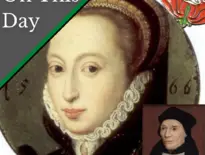On this day in Tudor history, 6th May 1502, in the reign of King Henry VII, Sir James Tyrell, former royal councillor, was executed for treason due to his links to a known traitor.
But it's not for his time as a trusted councillor, or for his links to a claimant to the throne that he is known, but for his alleged involvement in the murders of the Princes in the Tower.
Find out more...
On this day in Tudor history, 6th May 1471, Edmund Beaufort was executed at Tewkesbury following the Lancastrian defeat at the Battle of Tewkesbury during the Wars of the Roses.
How did he come to be executed when he was in sanctuary, and why was this the end of the Beaufort line? What did this mean for the Lancastrians?
Find out in this #TudorHistoryShorts video...
And on this day in Tudor history, 6th May 1541, King Henry VIII issued an injunction ordering the Great Bible to be available in every church in England.
But what was this Bible?
Who had worked on its translation?



James Tyrell had nothing to do with the Princes in the Tower aka their alleged murder. The story is from Thomas More and it’s the most ridiculous story you ever read. For one thing Richard is meant to be on the loo when he has this talk with Tyrell and gave the alleged orders. The so called confession from James Tyrell was never found. Tyrell only makes this so called confession because he was going to be executed and he was allowed to be beheaded instead of hang drawn and quartered. The two men who then do the alleged deed walk free. Yes, of course they do. And why get him to confess now?
Well Henry Vii needs a fall guy to reassure the rest of his realm as he now has the last challenge to his insecure and stolen crown in his power. The Princes have to be dead because H7 was daft enough to make them legitimate. He is running out of his own heirs and he needs a propaganda coup. So he might as well blame Tyrell in order to reduce his sentence for treason.
However, there is another story which More doesn’t write about but existed that James Tyrell actually cared for the Princes or at least one of them at his home in Gipping Hall. The story roughly goes that Tyrell was sent by Richard to take custody of one of the Princes, now a Lord not a Prince, just before Bosworth and to take them to safety. When it all goes wrong James protected the boy under an assumed name for some time at Gipping Hall. Things became too hairy so he was sent abroad and thus returned later as Warbeck. This is one of many possible survival stories which are explained by Matt Lewis in his book. He doesn’t say this did happen but that there are clues that lead to this possibility if we follow the bread crumbs as it where.
David Starkey tried a few years ago to prove that the connection with Tyrell was correct and that the Warbeck thing was nonsense by showing that Henry was present in the Tower during these trials. However, Tyrell was tried at the Guildhall as was Warbeck. Henry used the Tower as a Royal residence a lot more than even the Plantagenet Kings. It was also common practice for royalty to be close by during treason trials and to take up residence in the most secure place. Henry Viii and later Tudors didn’t because of the use they made of the Royal Apartments for state prisoners. If the place had gained a reputation for royal murder that isn’t surprising. It was used for coronations still but very rarely after the death of H7. Even the redecoration for Anne Boleyn was in 1536 was a rare event.